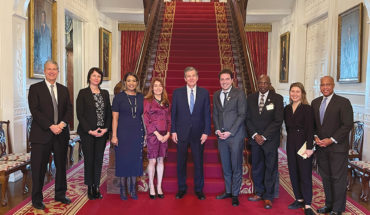by Amber Nimocks
photographs by Juli Leonard
Bold, staring orbs, fractured picture frames, and bright geometric elements give the sculptural paintings of Raleigh’s own Lope Max Diaz a visceral presence. Through his signature use of shape and color, Diaz can evoke memories of his adolescence in Puerto Rico, or allude to stories of his adoptive North Carolina.
His works employ texture, negative space, and arrangement to speak in a unique language refined over the course of a celebrated career in art and design.
The 2003 recipient of the Raleigh Medal of Arts, he has also been awarded the Centennial Medal from the University of Puerto Rico and has served on the Raleigh Arts Commission, the North Carolina Arts Council, and the National Endowment for the Arts’ visual arts grant review board. Diaz’s work appears in the permanent collections of the Mint Museum of Art in Charlotte, the Irish Museum of Modern Art, and the Instituto de Cultura Puertorriqueña in San Juan, Puerto Rico, among many others.
But as accomplished an artist and designer as Diaz is, the medium he understands best may not be paint, but people.
As a teacher, Diaz has a knack for seeing students’ talent and for helping them channel their gifts to their greatest advantage. He taught art and design at the University of Puerto Rico for many years before moving to N.C. State University in 1988 to teach design fundamentals and painting in the College of Design.
Diaz retired in 2009, but not before he had a chance to influence countless accomplished students, including one of the college’s most celebrated graduates of recent memory. Justin LeBlanc, a finalist on Project Runway this season, was an architecture major when he took Diaz’s studio class in fashion design in 2008. For his studio project, LeBlanc created interpretations of the seven deadly sins for the College of Design’s annual Art2Wear show.
Diaz took note of LeBlanc’s work and felt compelled to tell him, “Justin, you’re not an architect, you’re a fashion designer.”
Diaz was a bit conflicted about speaking up, he says, because LeBlanc was a senior, months shy of completing an architecture degree. But Diaz says he could tell that LeBlanc had a heart for fashion design.
“It was the evidence of this passion that he was displaying, and his receptiveness of sincere criticism when it was necessary,” Diaz said.
It turns out Diaz was right, as he has been many times before. His eye for talent became evident with his first class of high-school art students, which included internationally acclaimed fashion designer Julio Espada, who led the Italian design house Pucci for a time, and Arnoldo Roche, a neoexpressionist painter whose work is collected in the Metropolitan Museum of Art in New York and the Hirshhorn Museum in Washington, D.C.
A list of Diaz’s former N.C. State students reads like a who’s who of Raleigh’s young artists scene: painters Luke Buchanan, Ryan Cummings and Casey Porn; video artist Timothy Kiernan; photographer James West. And even those who didn’t pursue a career in art rave about how his words changed their life, inspiring them to see in themselves what Diaz saw.
“Students I’ve determined are promising – those are the ones I’ll be harder on, and I spend more time with them,” Diaz said. “I always give the best of myself and try to be very honest with my assessments of their capabilities.” Striking a balance between useful criticism and sincere encouragement can be difficult, he says.
“Many times it’s just trying to help them turn down the excess that comes from being really ambitious,” he says. Diaz recalls a student who was eager to make a bold statement about sexism and commercialism with her senior project. Her chosen medium: adult sex toys.
“In a way, they throw these things out to see if their teacher might censor them,” he says. Diaz coaxed her away from the confrontational nature of a visual display and suggested a more shrewd, sophisticated approach.
So rather than a mobile, the student created a sound recording, a miniature symphony in which the whirr and hum of each of the small machines, juxtaposed with human moans, played a part. It was a lesson in the power of nuance. Diaz still hears from that student regularly. She recently sent him a pouch of rare tea from China.
“One of the great things about the way he teaches is he lets everyone’s independent style show through,” says former student Tracy Spencer-Stonestreet, now a professor of art at Hampton University.
Diaz is a tidy man, whose subdued appearance belies a vibrant imagination. Greeting visitors to his home studio, he wears a crisply ironed olive-green button-down tucked into comfortable jeans and a leather belt. His speech bears a faint Puerto Rican accent. Talk with him for a while, and it’s easy to understand why his students rave. Diaz listens as much as he speaks, and when he talks you sense he is sharing his talents, like a set of tools that he’s happy to show you how to use. But a gleam in his eye tells you that he knows something – probably quite a lot – that you don’t know, so you listen closely.
Since Diaz retired from teaching four years ago, he has settled into retirement, moving his studio from the Carter Building, an artist colony on Glenwood South, to the garage in his West Raleigh home. Pristine white walls provide the perfect complement to the bold shapes and powerful colors of his abstract, autobiographical paintings. The sealed concrete floor is smooth and spotless. A neatly organized collection of saws and clean paint rollers sits by the work table near acrylic paints and buckets of varnish. Professional grade LED lighting gives the low-ceilinged space a pleasing glow.
Diaz was born in Puerto Rico and moved with his family to New York when he was young. They returned to the island when Diaz was in middle school, and he graduated from high school and the University of Puerto Rico with a bachelor’s in fine arts. It was the late 1960s, which meant that once he was out of school, Diaz was eligible for the draft and possible assignment to Vietnam.
“I wasn’t interested in going to this war, and I wasn’t interested in going to federal court,” he said. So he became an elementary school teacher to earn a deferment and found that it helped him to understand art in a new, more meaningful way.
“Those were my most challenging years in teaching because this kids would always say ‘por que – why, why, why?’” Diaz said.
He had studied art himself for years, but it had been a long time since he’d had to examine the fundamental understanding upon which his knowledge was built. Having to explain it clarified his own understanding. It turned out Diaz loved teaching so much that he took additional courses, including graduate studies at Hunter College in New York. Afterward, he landed a job teaching at the best arts high school in San Juan. His success in teaching Espada and Roche – those first students who went on to such spectacular careers – confirmed his career path.
Teaching high school then gave way to teaching design and painting at the college level. Diaz made the acquaintance of Wayne Taylor, then a professor at N.C. State’s College of Design, and mentioned that he might be interested in experiences beyond his current role. When the college had an opening, Taylor passed on the news. Diaz and his wife Aixa were eager for an adventure, and their children were 12 and 18, so the timing was right.
“We thought, ‘We’ll go for one or two years; if we don’t like it, we’ll just move back,’ ” he says.
Their son, Lope Max Diaz II, is now a lawyer in Charlotte, and their daughter, Aixa Diaz, is a television news anchor in Orlando. Raleigh was a good fit, and they have been joined by other family members in the area.
As he steps away from his career as a teacher, Diaz says he worries about the state of arts education, particularly the influence of technology on creativity. He continues to be involved in the lives of young artists, participating in critique sessions and offering one-on-one advice. Art students today are using software that is embedded with the values of the developer, he points out, sacrificing elements of originality for the convenience of a device.
“You end up losing freedom of expression – unconsciously,” he says.
But it’s not just the rise of technology that concerns him, it’s also the retreat of humanity.
“Teaching is going to change to being filtered through a device rather than through the direct touch of the hand,” says Diaz. It’s a message that resonates coming from a man who has spent a lifetime in hands-on instruction, telling students eye-to-eye whether their talents might sustain their dreams.






